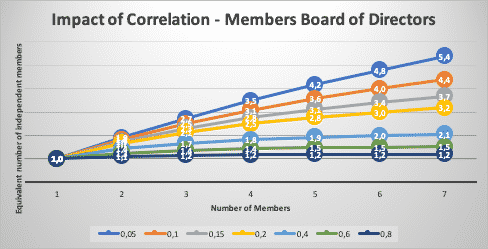septiembre 29, 2020
About “diversity / inclusion” on corporate boards
Companies increasingly recognize the distinction between diversity and inclusiveness: diversity is counting the numbers; inclusiveness is making the numbers count. Boards need to improve on both dimensions.
The point is, when you search for diversity you are aiming to have a good range of different opinions, types of things or people being included in something. A range of people, which can discuss a specific subject using different lenses, will enhance the conversation. Purpose – add value.
How to take advantage of diversity?
Great talent alone is not enough to create a well-functioning board. Boards need formal processes and cultures that leverage each individual member´s contribution as well as the directors´ collective intellect.
We tend to think selection should be based solely on qualifications and experience; the high point is to select the most qualified board members. The good part is when after the selection process, you look back and find that the chosen group met diversity expectations, by gender, race, sexual orientation, and religion, among others.
It is important to enhance the following aspects as attributes of a successful board:
- Communicate effectively
- Ask tough questions or move boardroom discussions forward in skilled and effective ways toward accurate decision making.
- Offer a good range of experience and knowledge: marketplace, industry – consumer preferences, support- functions, strong relations with stakeholders, etc.
- Well-run general meetings, according to the subjects included in the agenda and under the expected timing.
- Candid and collegial tenor.
- Productive relationships with senior management.
- Fiduciary duty to ensure the business is sustainable.
- Build the necessary resilience in its environment.

Our methodology is to search for members of the board who can add value aiming to meet the organizational strategy; according to their experience, knowledge and strengths in a specific industry, function, region, relations, networking, or knowledge.
We have had several experiences facing this challenge. Let us analyze the two extremes:
- When you have a correlation of members equal to zero it means that they are totally independent in their knowledge. It will be a straight line where the number of members will be exactly equivalent to the number of independent members, with an ample range of knowledge. The risk is that you have one voice per subject.
- On the contrary, and as you can see it in the image above, if you have a high correlation (0,8) even though you have a number of 7 members it can be equivalent to 1,2 member, in the worst scenario.
- In an intermediate scenario, with a correlation of 0,05; 5 members are equivalent to 4,2 independent members.
We don´t have a straight answer but what we do know is that you should be able to map this situation, identify which members are adding value to strategy and which voices are heard. It takes more than great talent to make a great board. Talent alone cannot overcome dysfunctional dynamics.
How do you define if an executive is the right talent as a member of the board?
- First- understand strategy and identify strategic objectives.
- Second- make a list of the requirements in terms of experience and knowledge you need to search for to meet the strategic objectives.
- Third- identify the talent which meets the requirements.
- Fourth- make sure you have met the requirements of your checklist.
- Fifth- work in their relations and ways to communicate to assure they are giving the best of their potential.
Some people ask: IS DIVERSITY A PLUS OR A MUST?
Answer: congruency is fundamental, if you want diversity you need to behave with inclusion: honestly considering all the ideas, opinions, ways to analyze, experience and knowledge without discrimination.
Making the members count as a solely part of the group is a MUST.
Recomended –> Cómo se clasifican las empresas según su tamaño

